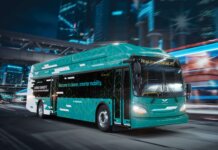Reaffirming its commitment to support fuel cell and additional hydrogen-related products and technology toward a hydrogen economy, Toyota Motor North America (TMNA) is renaming the TMNA research and development (R&D) California office as its new North American Hydrogen Headquarters (H2HQ).
The office workspace at the new H2HQ was recently redesigned for its teams working from R&D to commercialization planning and sales of hydrogen-related products and technologies. Key features are planned for the H2HQ campus in the future such as a flexible microgrid and sustainable customer education center.
“Toyota has developed hydrogen fuel cell electric solutions for more than three decades, and we will continue to advance this scalable, zero-emission technology as part of our electrified portfolio,” says Ted Ogawa, president and CEO of TMNA. “Renaming this facility as North American Hydrogen Headquarters represents our leadership in fuel cell development, creating real-world products to help reduce carbon emissions.”
In 2023, Toyota Motor Corporation reorganized its hydrogen business in Japan to create what it calls “Hydrogen Factory” with the idea to bring all hydrogen-related work under one location and accelerate customer-oriented product development and production in fuel cell or hydrogen-related products. Then, Toyota Motor Europe announced its own Hydrogen Factory with the aim to further grow Toyota’s hydrogen business and stimulate wider roll-out of hydrogen ecosystems and infrastructure across Europe.
H2HQ will drive North American-led hydrogen initiatives and support the localization of global hydrogen-related technologies and products that include light-duty fuel cell applications, heavy-duty fuel cell opportunities, stationary fuel cell power generation and port vehicle applications.
The facility already provides impressive R&D assets, including Toyota’s largest dynamometer (1.2 MW), a scalable test bench for stationary applications, and a hydrogen fueling station capable of providing fuel for both light- and heavy-duty vehicles. Moreover, as part of its plans to retain and grow fuel cell leadership, NA H2HQ will be home to several new projects in the coming years.
Construction has begun on a flexible microgrid that features energy sources available today, including a 230-kW solar photovoltaic system, a 1-MW stationary proton exchange membrane (PEM) fuel cell generator, 325-kW solid oxide fuel cell (SOFC) and an onsite 500-kWh battery energy storage system. The microgrid is designed to support the campus’ energy needs, allowing it the ability to operate off-grid. The system is expected to be fully operational by 2026.
“California has ambitious goals to achieve clean air, carbon neutrality and a vibrant economy,” says Liane Randolph, California Air Resources Board (CARB) chair. “Toyota’s investment to expand their research and development of hydrogen fuel cell technology in our state is an example of the innovation that will accelerate the development and deployment of zero-emissions transportation options, particularly as we decarbonize the goods movement sector.”






